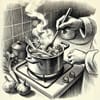Welcome back to our regular feature where we sift through thousands of new, health-related papers, and pick a few to summarize in a practical, simple, and not anxiety-inducing way.
Our main questions on each paper:
- In simple language, what does it say?
- Does it have good evidence?
- Should what it says matter to normal people?
- What simple thing, if anything, could a normal person do to take advantage of this finding?
Okay, away we go. And, as always, we rate each paper for practicality and level of interest, but we are mostly focused on finding ways to simplify findings. And more than anything else, we want to avoid over-optimization, so if a paper is telling you down to the minute how much sunlight to get at dawn, or that you should only drink coffee during eclipses, we are outta there.
This edition's articles and papers:
- Skeletal site-specific effects of jump training on bone mineral density in adults: a systematic review and meta-analysis: Journal of Sports Sciences: Vol 41 , No 23 - Get Access https://www.tandfonline.com/doi/full/10.1080/02640414.2024.2312052
- Dsm-firmenich sees boost as weight-loss drugs spur healthier choices | Reuters https://www.reuters.com/business/healthcare-pharmaceuticals/dsm-firmenich-sees-boost-weight-loss-drugs-spur-healthier-choices-2024-06-10/?utm_campaign=KHN%3A%20Daily%20Health%20Policy%20Report&utm_medium=email&_hsmi=311066902&utm_content=311066902&utm_source=hs_email
- Racing the time – mtnath.com https://mtnath.com/racing-the-time/
- The Assessment, Management and Prevention of Calf Muscle Strain Injuries: A Qualitative Study of the Practices and Perspectives of 20 Expert Sports Clinicians - PMC https://www.ncbi.nlm.nih.gov/pmc/articles/PMC8761182/
Now, here are our takes on the articles and papers:
Paper: Jumping More for Bone Health
Practicality (5/5): 🏃♂️🏃♂️🏃♂️🏃♂️
Interest (5/5): 🏃♂️🏃♂️🏃♂️🏃♂️🏃♂️
Summary
This study examines how effective jump training is for improving bone mineral density (BMD) in adults. It shows that jumping regularly can increase BMD, particularly in the crucial femoral neck region of the hip. The results vary by age and the specific bone area, with younger adults benefiting more.
What is the paper's main claim?
- Bone density is deteriorating on developed societies as young people become more sedentary
- Jump training can increase bone density, especially in the hip area of younger adults.
- Benefits are modest but statistically significant, suggesting practical relevance for bone health.
Are the methods and/or RCTs it uses appropriate and convincing?
- The meta-analysis covers 19 trials and 666 participants, which supports robust conclusions.
- The reported effect sizes are small to moderate, suggesting changes are meaningful but not dramatic.
What do we know now that we didn't know before, if anything?
- Jump training is particularly effective at increasing BMD at the femoral neck, more so than other areas like the lumbar spine.
- The study confirms age-related differences in BMD response to jump training, with younger adults seeing more benefits.
What simple and practical thing could a normal person do knowing this?
- Incorporating 50 jumps four times a week into routines may help improve hip bone density, and is particularly beneficial for younger adults aiming to enhance bone health.
- Go back in time and jump a lot more as a kid, and applaud your kids jumping out of trees now.
Paper: Food Weight Loss Drugs and Food Purchasing
Practicality (3/5): 🏃♂️🏃♂️🏃♂️
Interest (4/5): 🏃♂️🏃♂️🏃♂️🏃♂️
Summary
The rising popularity of new weight-loss drugs is increasing interest in dietary supplements and healthier foods. These drugs help people lose weight quickly, which creates demand for additional nutrients, particularly proteins given muscle loss.
What is the article's main claim?
- New weight-loss drugs are driving demand for dietary supplements and healthier food options.
Are the methods and/or data it uses appropriate and convincing?
- The paper primarily uses expert opinions, market trends, and business growth forecasts.
- It lacks detailed empirical data, making the claims more speculative than certain.
What do we know now that we didn't know before, if anything?
- Weight-loss drugs can significantly shift market demand towards healthier food products and supplements.
- Consumers are increasingly aware of the muscle-loss consequences of new weight loss drugs
- Companies are anticipating and preparing for this shift with innovative new ingredients.
What simple and practical thing could a normal person do knowing this?
- Recognize that new weight loss drugs, while very effective, come with consequences, like muscle loss.
- Focus not just on weight loss but also on maintaining balanced nutrition, particularly protein intake, and related resistance training.
Paper: Kilian Jornet on Aging and High Performance
Practicality (5/5): 🏃♂️🏃♂️🏃♂️🏃♂️🏃♂️
Interest (5/5): 🏃♂️🏃♂️🏃♂️🏃♂️🏃♂️
Summary
This article by elite climber, ultrarunner, and skier Kilian Jornet explores how athletes can maintain high performance in aging. Jornet points out that consistency, stress management, and intrinsic motivation are crucial for longevity in sports. The author shares personal experiences and insights from other successful athletes to highlight the importance of these factors.
What is the article's main claim?
- Sustained high performance in sports depends on consistency, wise training load management, and stress management.
- Intrinsic motivation and overall health are key to navigating the challenges of aging.
Are the methods and/or data it uses appropriate and convincing?
- The claims are mainly derived from personal experiences and observations rather than empirical data, which can introduce biases.
- While the ideas are compelling, they are anecdotal not conclusive, even if Jornet should be taken seriously.
What do we know now that we didn't know before, if anything?
- The novelty lies in the emphasis on a holistic approach—mental, emotional, and lifestyle—rather than high-tech or dietary solutions for athletic longevity.
What simple and practical thing could a normal person do knowing this?
- Maintain a consistent exercise routine and manage stress effectively.
- Focus on intrinsic motivation and enjoy the activity to build resilience and longevity in any pursuit.
Paper: Managing Calf Muscle Injuries
Practicality (4/5): 🏃♂️🏃♂️🏃♂️🏃♂️
Interest (4/5): 🏃♂️🏃♂️🏃♂️🏃♂️
Summary
Calf muscle injuries become increasingly common with age. The paper summarizes top practitioners' approaches to diagnosing, treating, and preventing calf muscle injuries. They emphasized a careful, step-by-step approach to determine the injury, guided by key principles to help athletes return to play safely. Preventing these injuries is complex, requiring personalized strategies rather than one-size-fits-all programs.
What is the paper's main claim?
- Experts recommended a rigorous approach to evaluating, treating, and preventing calf muscle injuries.
- Personalized strategies are necessary to manage these injuries effectively, but there is a six-step approach that can be used.
Are the methods and/or data it uses appropriate and convincing?
- The study interviewed 20 expert clinicians, with diverse backgrounds, offering a broad view; however, it's qualitative and relies on expert opinion, which can introduce bias.
- Sample size and diversity are reasonable but bear in mind that larger, more controlled studies could provide more generalizable findings.
What do we know now that we didn't know before, if anything?
- The study provides a detailed process from experienced professionals for diagnosing and treating calf injuries, offering a comprehensive, practical guide.
What simple and practical thing could a normal person do knowing this?
- Athletes might benefit from regular and varied lower leg exercises tailored to their specific risks and needs to help prevent calf muscle injuries.
- Calf injuries are increasingly common with age, and they need to be rehabbed properly to prevent recurrence and becoming chronic
Back next week with thoughtful and simplifying takes on papers getting attention. And if you see anything you want us to look at, let us know.





